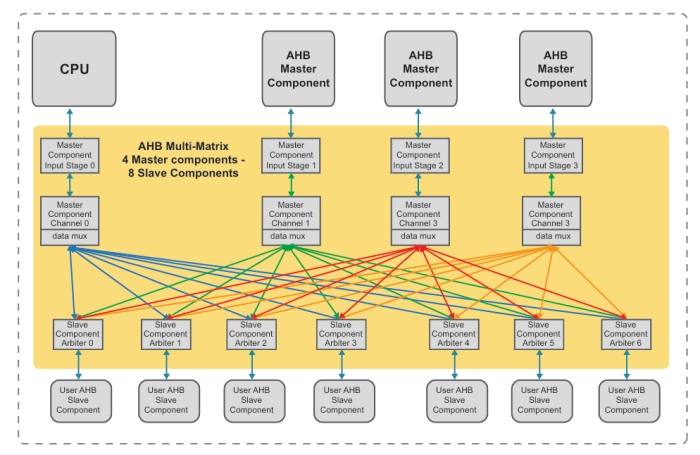The AHB Fabric provides the necessary infrastructure to connect up to 16 shared AHB Slaves to up to 16 AHB-Lite Bus Masters. The off-the-self configuration support 4 AHB Masters and 7 AHB Slaves and includes a remapping selection.
In a typical AHB system, several AHB Masters may compete for a shared (AHB) bus; a bus arbiter determines bus ownership. The AHB Fabric allows for the various AHB-Lite Masters to connect to several different shared peripherals without the need to arbitrate for a shared AHB bus. Instead, arbitration is performed at the peripheral. This way, the various Masters may see a significant increase in performance over a standard AHB system. However, systems where multiple masters need frequent access to the SAME peripheral will see only a modest performance increase.
The Fabric may be connected to the remainder of the subsystem as follows. Each of the AHB Fabric’s M Mirrored Slave Ports is connected to an AHB Slave module (e.g. External Bus Interface, Memory Controller, AHB-to-APB Bridge). On the Master side, each of the N-1 AHB Fabric’s Mirrored Master Ports is connected to either the output side of an AHB Arbiter (in the case where each AHB system has multiple bus Masters) or directly to an AHB or AHB-Lite Master such as a microprocessor.
AHB Multi Fabric
Overview
Key Features
- AMBA® 2.0 Compatible
- Multiple AHB Channels
- Off the shelf core supports 4 Masters and up 7 Slaves
- Arbitration is done at each slave
- Other configurations are available
Block Diagram

Deliverables
- Verilog Source
- Complete Test Environment
- AHB Bus Functional Model
Technical Specifications
Maturity
Silicon Proven
Availability
Now